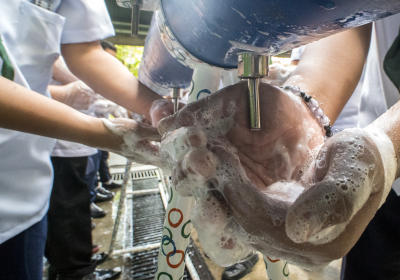In May 2018, the Regional Fit for School Programme and the Sector Programme Sustainable Sanitation (SV NaSa) presented in a webinar the latest developments of the prefabricated group washing facility WASHaLOT 3.0.
As more and more countries around the globe adopt group handwashing activities as part of their daily routines in schools, there is an increased demand for a low-cost washing facility, which is user-friendly and ensures functionality. Daily group hygiene activities in schools, supervised by the teacher, are a good practice to create healthy habits in schools, ensuring that students can actively perform what they learn in other settings like the household or family context.
The unique design of the WASHaLOT 3.0 was jointly developed with Professor Jens Nowak and his team from the University of Applied Science Potsdam. The design was developed based on years of experiences that the Fit for School programme has made with group washing facilities. The centerpiece of the system is the water saving outlet, which mechanically releases water only once it is touched. This reduces the amount of water needed for handwashing to a minimum. In addition, the WASHaLOT 3.0 can be prefabricated locally, thus nurturing local supply chains, creating incomes, ensuring quality and reducing the burden on schools to build their own facilities.
The webinar featured the results of the Technology Applicability Framework (TAF) assessment, which was conducted in 10 public schools in Batangas (Philippines) where 50 units of the WASHaLOT 3.0 were installed. The assessment showed that the WASHaLOT 3.0 was highly valued and appreciated by stakeholders. The assessment also indicated that the technology is feasible along several sustainability dimensions, but that future funding sources must be clarified. More information material such as users and producers manual and videos might be necessary. Factoring in the TAF results, the WASHaLOT 3.0 will be produced and used in other countries and will be tested in emergency settings.
A recording of the webinar and the accompanying presentation is available in the SuSanA library ready to download. Further discussions on the topic can also be found in the SuSanA forum.



